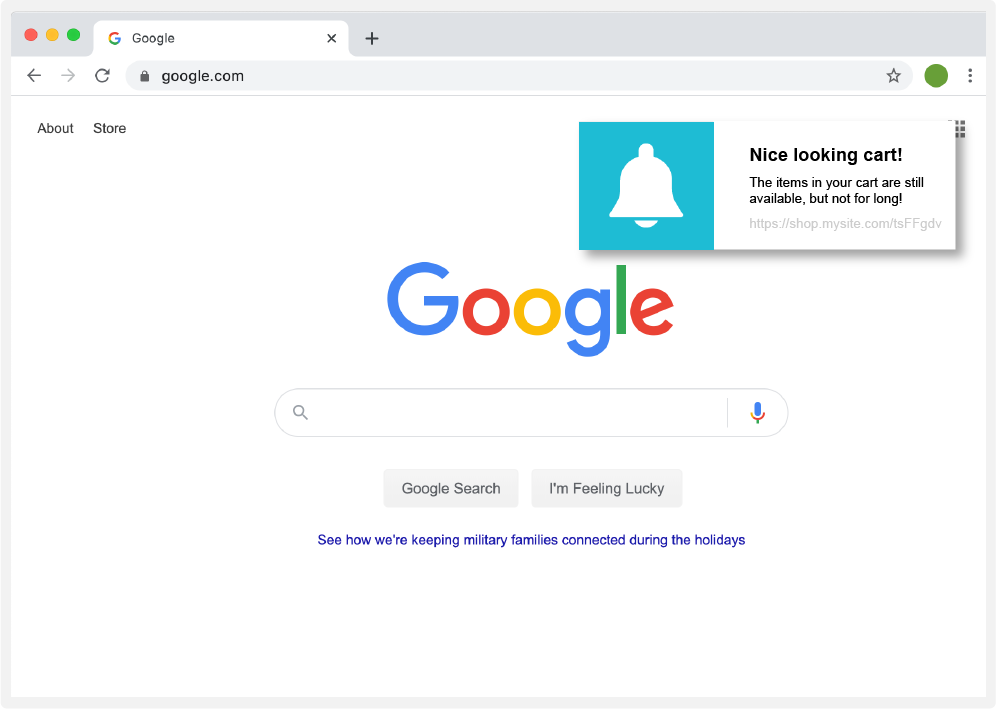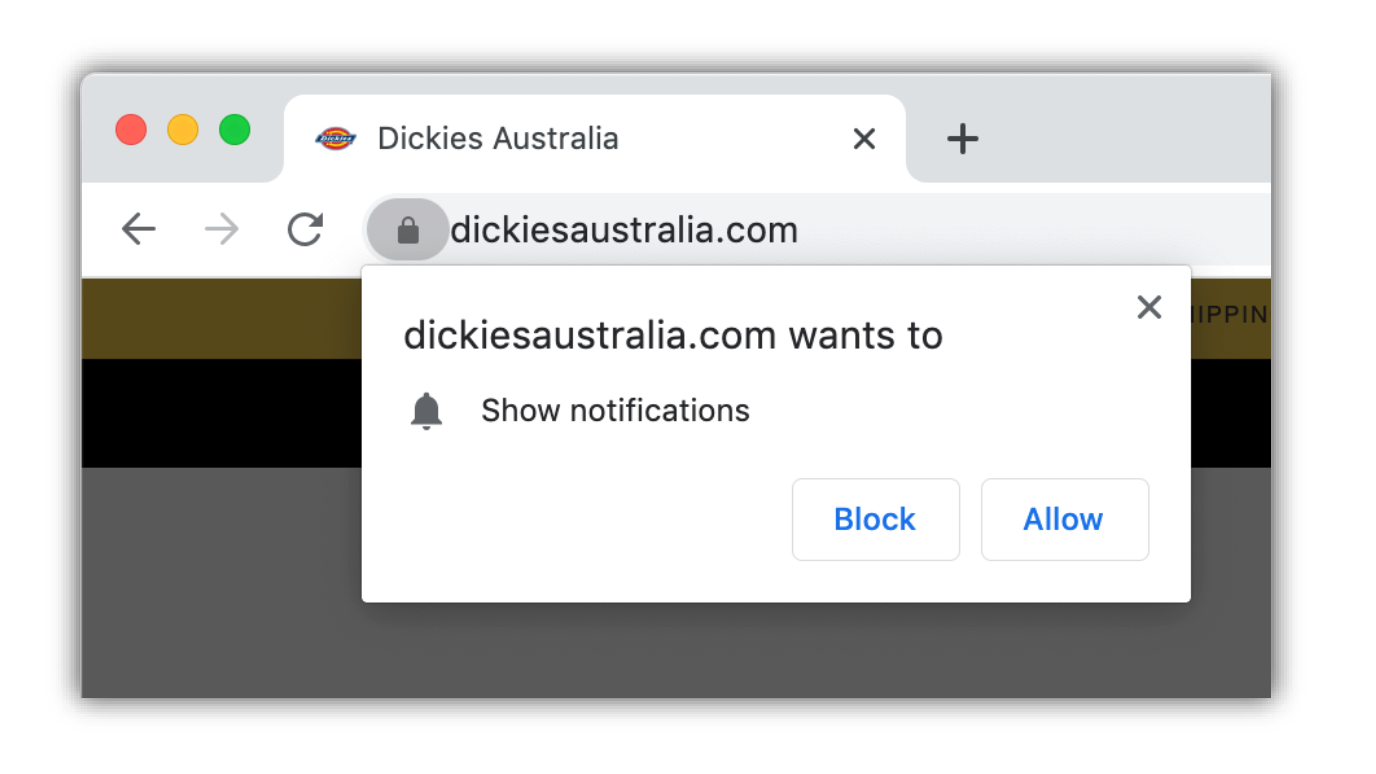Why Abandoned Cart Push Notifications Are Becoming Essential for Ecommerce
May 18, 2020
Wouldn’t it be nice to get your abandoned cart recovery message in front of your audience regardless of what they’re doing or which website they’re on? Well, that’s exactly what abandoned cart push notifications do.
We recently looked at multi-channel recovery tools that supplement your existing abandoned cart email strategy, by allowing you to reach shoppers in multiple places, and re-engage with them on their terms. One of those tools was abandoned cart push notifications.
Abandoned cart push notifications are on-screen notifications that remind, re-engage, return, and recover customers lost due to cart abandonment. And, even better, CartStack’s push notifications work on browse abandonment too – allowing you to maximize your lead pool to recover the most revenue possible from your website visitors.
Before delving into winning examples of push notifications (watch our blog), let’s first examine what browse abandonment and abandoned cart push notifications are, why they’re essential to your ecommerce business, and what goes into a winning notification.
What Are Browser Push Notifications?

Push notifications are timed, clickable messages that pop up on a website visitor’s desktop or tablet screen, regardless of whether they’re still on your website, or currently browsing the internet.
An abandoned cart push notification appears after a potential customer has visited your website, added products to their shopping cart, and left before finalizing their purchase.
A browse abandonment push notification appears after a potential customer has visited your website and left before adding any products to their shopping cart.
How do they work?
Push notifications work following an active opt-in from your website visitors. After a set amount of time browsing your website, shoppers receive a push notification subscription prompt, asking them if they want to allow notifications from you.

Once they have opted in, you can send these shoppers a timed push notification directly to their computer screen, made up of the following five features:
- An icon or image
- A headline
- A personalized message
- A call to action
As long as the shopper’s web browser is open in the background, your push notification will appear even if the shopper has left your website, finished shopping, or stopped browsing the internet.
The shopper can click the link to go back to your website or their shopping cart. Alternatively, they can dismiss the message to continue what they were doing.
Since push notifications are timed messages, you can create a trigger campaign that generates a series of notifications to remind, re-engage, return, and recover customers lost through cart or browse abandonment – much like your existing email recovery campaign.
The Benefits of Abandoned Cart Push Notifications
So what makes abandoned cart push notifications essential for ecommerce businesses already utilizing recovery emails?
Multi-channel recovery strategy
Browse and cart abandonment push notifications help you to build a multi-channel recovery strategy. This increases the chance of your messages being seen, read, and clicked on while allowing customers to re-engage with you on a channel of their choice.
Capturing leads without an email address
Push notifications don’t require an email address to work. This means that you can target customers who left your website before entering their email address, who entered an email address that they don’t check, or who provided an email address that they don’t own (we’re looking at you mickey@mouse.com!)
Capturing attention away from the inbox
Push notifications are also a powerful way to capture customer attention. The email inbox is notoriously crowded and increasingly difficult to enter. Push notifications operate away from the noise of the inbox and present themselves in front of your audience to immediately alert them about your message. Even if they’re dismissed, they’re still seen.
Further reading: Abandoned Cart Email Deliverability : Best & Worst Practices
Hotter leads
The active opt-in required for push notifications to work, means that push leads are hotter than your average leads. This allows you to segment your audience further and target your time and attention to customers who are more likely to re-engage with your website and convert.
Timing and platform
Finally, push notifications have the added benefit of appearing at the right time and place. They pop-up while your potential customer is on their computer or tablet, connected to the internet, and perfectly positioned to recommence their shopping journey.
And Browse Abandonment Push Notifications?
Our experience and research show that the benefits of abandoned cart push notifications are multiplied with it comes to your browse abandonment visitors. Why?
Firstly, since browse abandoners leave your website earlier in the shopping journey, you’re less likely to have obtained their email address, even with on-site recovery tools.
Secondly, by leaving earlier in the shopping journey, you’ve had less time to connect with these customers on an emotional level.
Finally, the average customer requires six touchpoints with your brand before making a purchase.
Push notifications enable you to get in front of this audience without an email address, trigger brand recognition with a logo and personalized content, and subtly increase touchpoints to build trust for a future sale.
How to set up an abandoned cart push notification campaign
Setting up browse and cart abandonment push notifications is simple – all you need is a goal, a tool, and an idea of scheduling.
Goal
First, it’s good practice to establish a goal for your push campaign, which will depend on whether the customer left before or after adding items to their shopping cart.
The goal of a browse abandonment push notification should be to re-engage customer interest in your brand and bring them back to your website to continue browsing.
The goal of a cart abandonment push notification should be to recover the customer interest in their shopping cart and bring them back to the checkout to finalize their purchase.
Tool
To send push notifications, you need a push notification tool with the following features:
- Cart abandonment functionality – the ability to trigger a multi-notification campaign when a shopper leaves your website after adding an item to their cart.
- Browse abandonment functionality – the ability to trigger a notification campaign if three messages when a shopper leaves your website before adding an item to their cart.
- Personalization tags – the functionality to insert personalized information into the notification, including the customer’s name and viewed products.
- Tracking – functionality to track clicks and conversions resulting from the push notification.
Scheduling
Since your push campaign will work alongside your email campaign, it’s good practice to ensure that they complement each other.
You can achieve this by ensuring that your messages adopt a similar tone and style, and that you offset the timing to create a steady stream of communication – not a bombardment of messages. We recommend three push notifications following abandonment.
Abandoned Cart Push Notifications Best Practice
Perfecting browse and cart abandonment push notifications can take a little more work, but is achievable by following these best practice tips:
Use a recognizable logo
The brain processes images 60,000 faster than text, meaning the logo used in your push notification is the first thing that your audience sees – make sure it’s recognizable.
Use the logo or image that’s prominent on your website, and that you use elsewhere to establish brand recognition.
Open with an attention-grabbing headline
The next thing your audience sees is the bold headline of your notification. While the bold text certainly makes your headline text stand out, what you use that text to say determines whether your audience reads on or automatically clicks the dismiss button.
An excellent way to do this is by using personalization and emotion relevant to your campaign’s goal. Let’s take a look at some examples.
Did you mean to leave this behind?
This headline works well because it immediately sparks attention by engaging interest and reminding them that they were shopping on your website. Perfect for browse abandonment.
Only two pairs of Nike Air Force 1 left!
This headline attracts attention by using the customer’s browsing history to denote relevance, and then recovers interest by using scarcity to incite loss aversion and fear of missing out. Ideal for cart abandonment.
Struggling to decide? We can help!
This headline creates attention by reminding the customer of their visit to your website, and engages interest by offering help and support. Best suited to browse abandonment.
Five people are looking at that garden tool!
This headline achieves attention by using the customer’s browsing history, while engaging interest by using social action and herd mentality to encourage purchase recovery. Great for cart abandonment.
Trigger action
After capturing attention and igniting engagement, it’s time to hit your audience with a message that triggers an action aligned with your goal.
To recap:
Browse abandonment = re-engagement
Re-engaging customers with your website and their shopping journey can be achieved through the following messaging:
- Reminding – reminding customers about their website visit and helping them to pick up where they left off.
- Helping – offering help and assistance with purchases to encourage shoppers to get in touch about problems they encountered.
- Encouraging – increasing trust in your brand or products by offering social proof through customer reviews.
Cart abandonment = recovery
Recovering abandoned carts and encouraging customers back through the checkout can be achieved with the following messaging:
- Scarcity – using low stock levels or product popularity to create a sense of scarcity and encourage customers to convert before they miss out.
- Urgency – creating an urgent need to purchase by providing time-limited discount codes and offers.
- Risk – removing the risk of purchasing their basket by providing social proof, product guarantees, or fast shipping.
Use personalization
We’ve mentioned personalization throughout this guide, but it’s so crucial that we’re giving it its own sub-heading.
Personalization is an excellent tactic for capturing attention, engaging interest, and re-igniting emotions. It also takes up minimal characters, making it ideal for your space-limited notifications.
Personalization in push notifications can be achieved by inserting the customer’s name, product views, or basket contents.
Include a clear CTA
There’s no doubt about it – call to action buttons increase click-through rates by telling your audience what to do next. However, your CTA must be clear about the next step so that you don’t scare customers off.
Allow opt-outs
Finally, ensure that you include a clear way for customers to opt-out of your push notifications.
Customers change their mind, accidentally click “allow” and lose interest all of the time – it happens. By offering a quick and easy way opt-out, you can focus your efforts on converting interested customers, rather than wasting your time handling complaints from disgruntled website visitors.
Abandoned cart push notifications – final thought
And that’s the why and how of browse abandonment and abandoned cart push notifications.
However, just one final thought before you head off into the sunset to implement your own.
While push notifications typically have a high opt-in rate, there will be customers who don’t opt-in, either out of choice or mistake.
It’s crucial that you continue using on-site tactics, email campaigns, and SMS messaging to reach those potential customers and anyone else who accidentally overlooks your push notifications. Together, your tools create the ultimate customer recovery campaign.





